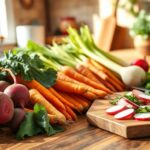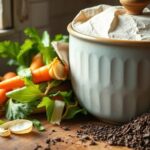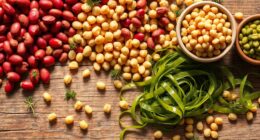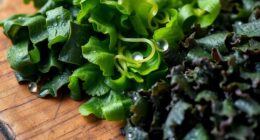To make vegetable scrap stock for zero-waste cooking, gather your vegetable scraps like onion peels, carrot tops, and celery leaves in a designated container kept in your fridge or freezer. When you’re ready, simmer them in water for an hour or two to create a flavorful, homemade stock. This method helps reduce waste, saves money, and supports eco-friendly kitchen practices. Keep going to discover tips that make the process even easier and more sustainable.
Key Takeaways
- Collect vegetable scraps like onion peels, carrot tops, and celery leaves in a designated, airtight container for easy recycling.
- Simmer the collected scraps in water for 1-2 hours to create flavorful, homemade vegetable stock.
- Use the finished stock in soups, stews, and risottos to enhance flavor and reduce reliance on store-bought options.
- Incorporate scraps into your kitchen routine to minimize waste and support sustainable, zero-waste cooking practices.
- Compost any leftover scraps after making stock to further reduce waste and enrich garden soil.
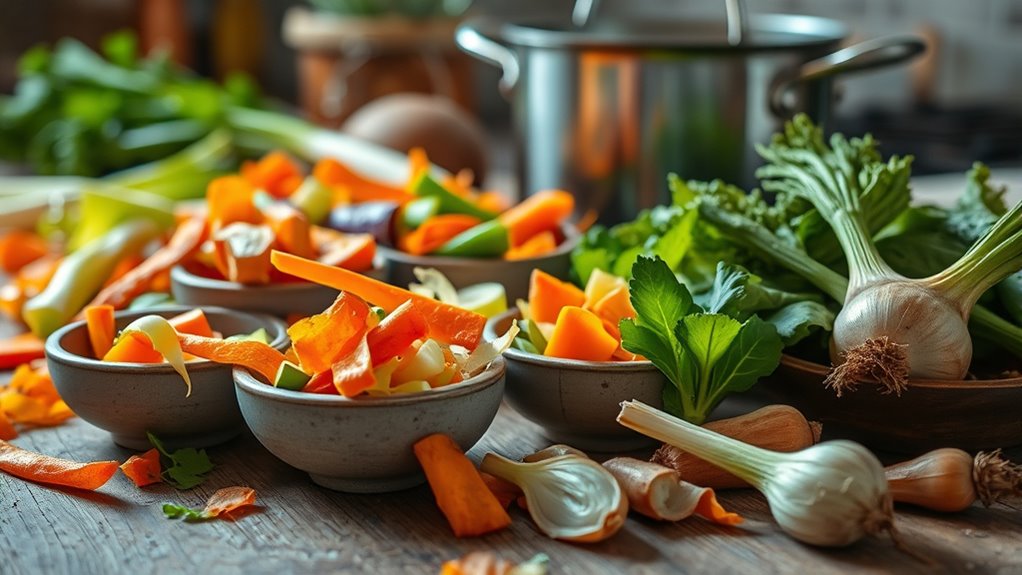
Have you ever considered how vegetable scraps can be transformed into a flavorful homemade stock? It’s a simple way to reduce waste and boost the flavor profile of your soups and stews. The key lies in implementing effective composting techniques and maintaining good kitchen organization. When you keep your kitchen tidy and your scraps accessible, it’s easier to repurpose every part of your vegetables rather than tossing them away.
Start by designating a specific container for vegetable scraps—onions peels, carrot tops, celery leaves, mushroom stems, and herb stems all make excellent stock ingredients. Having a dedicated bin keeps scraps contained and prevents clutter from spreading across your countertop. Make sure it’s leak-proof and easy to access, so you’re encouraged to save scraps regularly instead of letting them pile up in the trash. This approach encourages a habit of mindful waste management, aligning with composting techniques that turn kitchen waste into nutrient-rich compost for your garden. You can even keep your scrap container in the fridge or freezer, which prevents odors and keeps scraps fresh until you’re ready to make stock. Maintaining proper kitchen organization is essential for maximizing efficiency and minimizing waste.
Designate a dedicated, leak-proof container for vegetable scraps to keep your kitchen tidy and reduce waste.
Kitchen organization plays a crucial role here. When your workspace is efficient, it’s easier to gather scraps and keep your cooking area neat. Use labeled jars or containers to store vegetable scraps, and create a clear system for when and how to use them. Grouping scraps by type or frequency can streamline your cooking process. For example, keep onion skins and garlic peels separate from carrot tops and herb stems, so you can easily grab what you need when making stock. This organization minimizes waste and maximizes your use of ingredients, making your kitchen more sustainable and functional.
Once you’ve collected enough scraps, you can simmer them into a flavorful stock. Remember, the quality of your scraps directly impacts the taste—fresh, organic vegetables yield better flavor. When you follow proper composting techniques, you’re also helping the environment by reducing landfill waste. Plus, you save money by making stock from items that would otherwise be discarded. The process is straightforward: fill a large pot with water, add your scraps, bring to a boil, then simmer for an hour or two, extracting all those rich flavors. Afterward, strain out the solids, and you’ll have a homemade vegetable stock that’s perfect for soups, risottos, or braises.
Frequently Asked Questions
How Long Can I Store Vegetable Scrap Stock Safely?
You can store vegetable scrap stock safely for up to 4 to 5 days in the refrigerator. Make sure to keep it in an airtight container to prevent spoilage. Check for signs like a sour smell, mold, or sliminess before using. If you want to store it longer, freeze the stock for up to 3 months. Always trust your senses to identify spoilage signs before consumption.
Can I Reuse Vegetable Scraps for Multiple Batches?
Think of your vegetable scraps as treasure chests—you can reuse them for multiple batches, but not forever. Reusing scraps for batch preparation works best for 2-3 rounds before flavors start to fade, turning your stock into a bland ghost of its former self. Keep an eye on the taste and aroma; if they weaken, it’s time to start fresh. Reusing scraps saves resources, but quality should always come first.
Are There Vegetables That Shouldn’T Be Used in Stock?
You should avoid using toxic vegetables like bitter almonds or moldy scraps in your stock, as they can be harmful. Also, steer clear of vegetables with strong flavors, such as broccoli or cabbage, as they may compromise the overall taste. Focus on mild, fresh scraps like carrots, celery, and onion skins to create a flavorful, safe, and sustainable vegetable stock for your zero-waste cooking.
How Do I Prevent Cloudiness in Homemade Stock?
To prevent cloudiness in your homemade stock, focus on clarity enhancement through proper simmering techniques. Keep the heat gentle, avoiding vigorous boiling, which can emulsify fats and create cloudiness. Skim off any foam or impurities that rise to the surface regularly. Use cold water to start, and don’t stir too much during simmering. These steps help produce a clear, beautiful stock perfect for your zero-waste cooking.
Can Vegetable Scrap Stock Be Used in Canning?
Did you know that over 40% of food goes to waste, yet vegetable scrap stock can be used in canning? Yes, you can safely use it, especially when preserving flavors. Vegetable peels and scraps add unique flavor variations, making your canned goods more vibrant. Just guarantee the stock is properly sterilized and processed, and you’ll enjoy zero-waste cooking with delicious, homemade canned vegetables and broths.
Conclusion
Think of vegetable scrap stock as a hidden treasure chest, waiting to transform your kitchen waste into golden flavor. Just as a wise gardener nurtures every leftover seed, you turn scraps into rich, nourishing broth, giving new life to what was once discarded. With each batch, you’re weaving a tapestry of sustainability, where waste becomes wonder. Embrace this alchemy, and watch your zero-waste journey flourish like a lush, abundant garden.
Ilana has been a vegan for over 10 years. She originally made the switch for health reasons, but soon found herself becoming more and more passionate about the ethical and environmental implications of a vegan lifestyle. Ilana is the author of The Graceful Kitchen, a blog all about veganism. She loves to cook up delicious and nutritious vegan meals, and share her recipes with others who are interested in leading a cruelty-free life. Ilana is also a strong advocate for using whole foods as the foundation of a healthy diet, and believes that going vegan is one of the best ways to achieve this.




